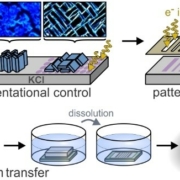F-Center Mediated Growth of Patterned Organic Semiconductor Films on Alkali Halides – Publication by A2 (Witte)
In a combined experimental and theoretical study, the groups of Gregor Witte (A2) and Jérôme Cornil from the University Mons present a new approach of patterning organic semiconductor films with simultaneous molecular orientation control based on an electrostatic stabilization at the film/substrate interface in the presence of F-centers in alkali halide substrates created by controlled electron irradiation.

Scheme of the process chain that allows transfer of patterned organic films to any non-water-soluble substrate. Reprinted with permission from ACS Appl. Mater. Interfaces 2022. Copyright 2022 American Chemical Society.
A key problem in organic electronics remains the lateral patterning and structuring of organic films for device applications since photolithography is not applicable due to the lack of chemical robustness of the organic materials in the etching process. Therefore, alternative approaches are necessary for the patterning of organic films.
In this study, Darius Günder et al. demonstrate that electron irradiation of KCl(100) substrates induces surface localized F-centers (halide vacancies) that strongly influence the molecular orientation and lateral structure of subsequently grown organic films. By combining AFM, SEM and XRD measurements they show for the case of dinaphtothienothiophene (DNTT) that molecules adopt a recumbent molecular orientation and form elongated fibers while hexagonally shaped islands with upright orientation are present on pristine KCl. Interestingly, both morphologies exhibit epitaxial alignments that are understood by higher-order commensurabilities. A complementary DFT-based theoretical analysis in the group of Jérôme Cornil identified electrostatic interactions between F-centers and interfacial DNTT molecules as origin of the different film morphologies. Furthermore, shadow masks or electron beam lithography techniques also allow spatially selective surface irradiation to generate patterns of F-centers, and thus enable lateral structuring of DNTT films.
Finally, it could be shown that due to the water solubility of the alkali halide growth templates, the patterned organic films can also be transferred to other substrates, including amorphous elastomeric plastic substrates, while the lateral and orientational order remain fully intact, hence underlining the great potential of this new patterning method for device applications.
Publication
D. Günder, V. Diez-Cabanes, A. Huttner, T. Breuer, V. Lemaur, J. Cornil, G. Witte
F-Center-Mediated Growth of Patterned Organic Semiconductor Films on Alkali Halides
ACS Appl. Mater. Interfaces (2022) DOI:10.1021/acsami.2c13934
Contact
Prof. Dr. Gregor Witte
Philipps-Universität Marburg
SFB 1083 project A2
Tel.: 06421 28-21384
EMAIL







